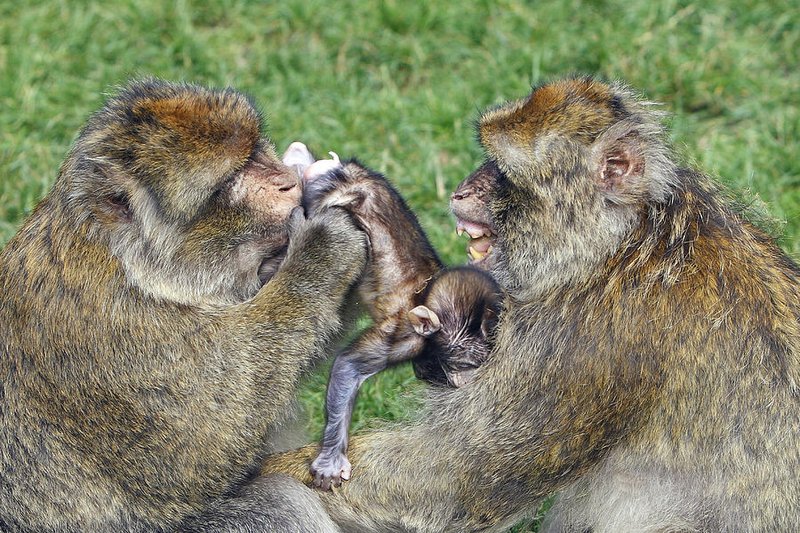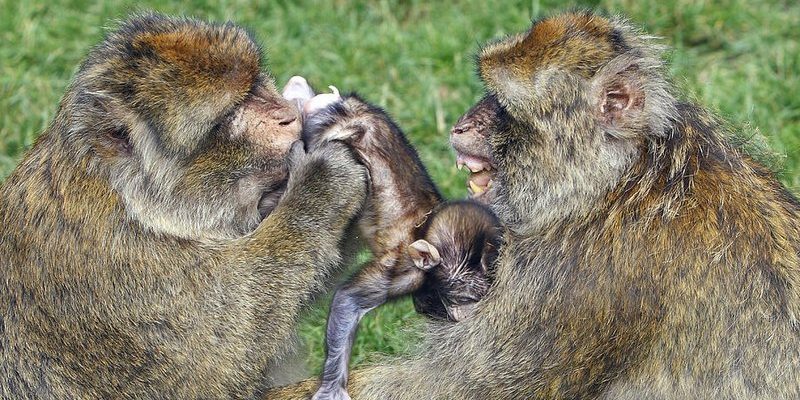
The Barbary Macaque is a fascinating primate that might not be on everyone’s radar, but it certainly deserves a spot in the conversation about unique wildlife. Imagine a monkey that resembles a small, furry human with expressive eyes and an endearing personality—this is the Barbary Macaque. Found primarily in the rugged mountains of North Africa, particularly in Morocco and Algeria, these creatures have adapted remarkably to their environment. They are the only species of macaque that live outside of Asia, making them a true curiosity.
You might be wondering what makes the Barbary Macaque so special. For starters, they are known for their social structure and intelligence. Living in groups ranging from 20 to 100 individuals, these monkeys display complex behaviors that can be both entertaining and enlightening for anyone lucky enough to observe them. Their social interactions are often filled with grooming, playing, and even communicating through a series of vocalizations, which adds to their charm.
In this article, we will explore everything you need to know about the Barbary Macaque—from their physical characteristics and habitat to their behavior and conservation status. So grab your coffee and let’s dive deep into the life of this intriguing animal!
Physical Characteristics
The Barbary Macaque is easily recognizable with its distinctive features. They have a thick coat of fur that can vary in color from sandy brown to gray. Their ears are small and rounded, while their faces are devoid of fur, giving them a somewhat human-like appearance. Adult males are generally larger than females, weighing between 40 to 66 pounds (18 to 30 kg), while females typically weigh about 30 to 50 pounds (13 to 23 kg).
One of the most interesting aspects of their appearance is their lack of a tail. Unlike many other monkey species, Barbary Macaques are tailless, which can be surprising for those not familiar with them. This tail-less look adds to their unique charm and perhaps even their human-like look. Their limbs are strong and well-adapted for climbing and foraging in trees.
In terms of size, an adult Barbary Macaque can reach about 18 to 26 inches (46 to 66 cm) in height. Their robust body and formidable teeth allow them to forage effectively for a diverse diet, which predominantly includes fruits, seeds, and leaves. They are also known to eat insects and small invertebrates, showing their adaptability to various food sources.
Habitat and Range
Barbary Macaques thrive in a range of habitats, but they particularly favor rocky, mountainous regions covered with oak and cedar forests. These habitats provide them with ample food and shelter from predators. In addition to their natural environment, Barbary Macaques can sometimes be found in areas close to human settlements, as they have become a familiar sight in tourist spots like the famous monkeys of Gibraltar.
Their adaptability is quite impressive. Barbary Macaques can often be seen in a variety of environments, from coastal scrublands to higher elevations where they can take advantage of the fruit trees. Nevertheless, their preferred home remains the cool mountainous regions where they can keep cool during the hot summers.
Interestingly, the range of the Barbary Macaque is quite limited compared to other monkey species. As mentioned earlier, they are primarily found in Morocco and Algeria, with some populations in Tunisia. The limited range also makes them vulnerable to habitat loss and other environmental factors, which we’ll discuss later in this article.
Diet and Feeding Habits
The Barbary Macaque is an omnivorous creature, meaning its diet comprises both plant and animal matter. They are opportunistic feeders, which means they take advantage of whatever food sources are available to them. Fruits, seeds, and nuts make up the bulk of their diet, but they will also consume leaves, flowers, and even small invertebrates when the chances arise.
Foraging behavior in Barbary Macaques is fascinating to observe. They often work together to find food, and their social structure plays a significant role in their feeding habits. Adult males might lead the way in searching for food while the other members follow. They are known to be quite clever, using tools like rocks to crack open nuts or to dig for roots and tubers.
This adaptability in diet not only helps them thrive in their natural habitat but also showcases their intelligence. They possess the ability to learn from their environment, remembering food locations and seasonal availability. In urban areas, they may raid garbage bins or visit markets, displaying an impressive problem-solving ability that helps them survive alongside humans.
Social Structure and Behavior
Barbary Macaques live in social groups, known as troops, which can range from a few individuals to over a hundred. These troops are usually composed of related females and their offspring, while males often migrate between groups, which helps maintain genetic diversity. The social interactions within these groups are complex and fascinating.
Within a troop, grooming is a crucial social activity. It serves not only to keep their fur clean but also helps strengthen social bonds. You might say it’s like a monkey spa day, where individuals take turns cleaning each other while enjoying the warmth of companionship. Effective grooming can help establish ranks and alliances, playing a key role in social hierarchy.
Communication is also vital in the social lives of Barbary Macaques. They use a variety of vocalizations, facial expressions, and body language to convey messages to one another. Whether it’s warning about approaching danger or greeting fellow troop members, these forms of communication foster a strong community spirit among the members. It’s a world full of chatter and connection, just like in any close-knit family.
Reproduction and Lifespan
When it comes to reproduction, Barbary Macaques are seasonal breeders. Females usually come into estrus, or “heat,” once a year, and males compete for mating rights. After a gestation period of around six months, a single infant is born. The young macaques are typically weaned at about six months, but they often remain with their mothers for much longer, sometimes up to two years.
Newborn Barbary Macaques are incredibly cute, with their big eyes and soft fur. Mothers are highly attentive and protective, ensuring their infants are safe and well-cared for. This nurturing behavior is vital for the young monkeys, as they learn the social dynamics of the troop and essential survival skills during their formative years.
As for lifespan, Barbary Macaques can live up to around 20 years in the wild, but some individuals have been known to live much longer in captivity—sometimes exceeding 30 years. Their longevity can be a result of better care and absence of predators in controlled environments. Yet, like any wild animal, their survival greatly depends on environmental factors and the presence of human activities.
Conservation Status
The Barbary Macaque is currently classified as Endangered by the International Union for Conservation of Nature (IUCN). Habitat loss due to deforestation, urbanization, and climate change poses significant threats to their survival. Additionally, they are often targeted for the illegal pet trade, further exacerbating their decline.
Fortunately, efforts are underway to protect this unique species. Various organizations are focusing on habitat preservation and rehabilitation, ensuring the survival of the Barbary Macaque in the wild. Local communities are also being engaged in conservation efforts, helping them understand the importance of protecting these animals and their habitats for future generations.
It’s important to remember that the survival of the Barbary Macaque is intertwined with the health of their habitats. By preserving forests and promoting sustainable practices, we can help ensure that these fascinating monkeys continue to thrive in the wild. Every little effort counts, and awareness is the first step towards effective conservation.
Interesting Facts
| Scientific Name: | Macaca sylvanus |
| Habitat: | Mountainous regions, oak forests |
| Diet: | Fruits, nuts, seeds, and insects |
| Lifespan: | 20-30 years |
| Weight: | 30-66 pounds (13-30 kg) |
| Height: | 18-26 inches (46-66 cm) |
| Social Structure: | Troops of 20-100 individuals |
FAQ
What do Barbary Macaques look like?
Barbary Macaques are medium-sized primates with a thick coat of fur that ranges from sandy brown to gray. They lack tails, which gives them a distinctive look. Their faces are hairless and expressive, resembling that of a small, furry human.
Where are Barbary Macaques found?
These macaques are native to North Africa, particularly in the mountainous regions of Morocco and Algeria. They are unique because they are the only macaque species found outside of Asia.
What do Barbary Macaques eat?
Barbary Macaques are omnivores, typically feeding on a mix of fruits, seeds, nuts, leaves, and small invertebrates. Their diet can vary based on the season and availability of food sources.
How do Barbary Macaques socialize?
Social life is crucial for Barbary Macaques. They live in troops where grooming is a regular activity to strengthen bonds. They communicate through vocalizations, facial expressions, and body language to maintain social order.
How long do Barbary Macaques live?
The average lifespan of a Barbary Macaque in the wild is around 20 years, but in captivity, they can live longer—up to 30 years or more, thanks to better care and less exposure to threats.
Are Barbary Macaques endangered?
Yes, the Barbary Macaque is classified as endangered due to habitat loss, poaching, and the illegal pet trade. Conservation efforts are in place to help protect their populations in the wild.
Can Barbary Macaques adapt to urban environments?
Yes, Barbary Macaques are quite adaptable. They can sometimes be found in urban areas near human settlements, where they may forage for food in garbage or interact with people, showcasing their intelligence and resourcefulness.
What is the significance of Barbary Macaques in their ecosystem?
Barbary Macaques play a vital role in their ecosystem as seed dispersers. By eating various fruits and seeds, they help in the growth of plants and trees, maintaining the health of their forest habitats.
How are Barbary Macaques being protected?
Conservation initiatives focus on habitat preservation, raising public awareness, and reducing illegal wildlife trade. Engaging local communities in these efforts is essential for the long-term survival of the Barbary Macaque.
What should I do if I encounter a Barbary Macaque in the wild?
If you come across a Barbary Macaque, it’s best to admire them from a distance. Avoid feeding them or attempting to touch them, as this can disrupt their natural behaviors and could lead to human-wildlife conflicts.

